Simulation and Fabrication of HfO2 Thin Films Passivating Si from a Numerical Computer and Remote Plasma ALD
Abstract
:1. Introduction
2. Experimental
3. Results and Discussion
4. Conclusions
Acknowledgments
Author Contributions
Conflicts of Interest
References
- Rahman, M.Z. Advances in surface passivation and emitter optimization techniques of c-Si solar cells. Renew. Sustain. Energy Rev. 2014, 30, 734–742. [Google Scholar] [CrossRef]
- Albadri, A.M. Characterization of Al2O3 surface passivation of silicon solar cells. Thin Solid Films 2014, 562, 451–455. [Google Scholar] [CrossRef]
- Simon, D.K.; Jordan, P.M.; Dirnstorfer, I.; Benner, F.; Richter, C.; Mikolajick, T. Symmetrical Al2O3-based passivation layers for p- and n-type silicon. Sol. Energy Mater. Sol. Cells 2014, 131, 72–76. [Google Scholar] [CrossRef]
- Dauwe, S.; Mittelstädt, L.; Metz, A.; Hezel, R. Experimental evidence of parasitic shunting in silicon nitride rear surface passivated solar cells. Prog. Photovolt. Res. Appl. 2002, 10, 271–278. [Google Scholar] [CrossRef]
- Cui, J.; Wan, Y.; Cui, Y.; Chen, Y.; Verlinden, P.; Cuevas, A. Highly effective electronic passivation of silicon surfaces by atomic layer deposited hafnium oxide. Appl. Phys. Lett. 2017, 110, 021602. [Google Scholar] [CrossRef]
- Wang, J.; Sadegh Mottaghian, S.; Farrokh Baroughi, M. Passivation properties of atomic-layer-deposited hafnium and aluminum oxides on Si surfaces. IEEE Trans. Electron Devices 2012, 59, 342–348. [Google Scholar] [CrossRef]
- Oulachgar, E.; Aktik, C.; Scarlete, M.; Dostie, S.; Sowerby, R.; Gujrathi, S. Electrical and optical characterization of SiONC dielectric thin film deposited by polymer-source chemical vapor deposition. J. Appl. Phys. 2007, 101, 084107-1–084107-5. [Google Scholar] [CrossRef]
- Singh, V.; Sharma, S.K.; Kumar, D.; Nahar, R.K. Study of rapid thermal annealing on ultra thin high-k HfO2 films properties for nano scaled MOSFET technology. Microelectron. Eng. 2012, 91, 137–143. [Google Scholar] [CrossRef]
- Yan, K.; Yao, W.; Zhao, Y.; Yang, L.; Cao, J.; Zhu, Y. Oxygen vacancy induced structure change and interface reaction in HfO2 films on native SiO2/Si substrate. Appl. Surf. Sci. 2016, 390, 260–265. [Google Scholar] [CrossRef]
- Deshpande, A.; Inman, R.; Jursich, G.; Takoudis, C.G. Annealing behavior of atomic layer deposited hafnium oxide on silicon: Changes at the interface. J. Appl. Phys. 2006, 99, 094102. [Google Scholar] [CrossRef]
- Neumayer, D.A.; Cartier, E. Materials characterization of ZrO2-SiO2 and HfO2-SiO2 binary oxides deposited by chemical solution deposition. J. Appl. Phys. 2001, 90, 1801–1808. [Google Scholar] [CrossRef]
- Hoex, B.; Heil, S.B.S.; Langereis, E.; Van DeBanden, M.C.M.; Kessels, W.M.M. Ultralow surface recombination of c-Si substrates passivated by plasma-assisted atomic layer deposited Al2O3. Appl. Phys. Lett. 2006, 89, 042112. [Google Scholar] [CrossRef]
- Srivastava, V.M.; Yadav, K.S.; Singh, G. Double-Pole Four-Throw RF CMOS switch design with double-gate transistors. In Proceedings of the 2010 Annual IEEE India Conference: Green Energy, Computing and Communication, INDICON 2010, Kolkata, India, 17–19 December 2010. [Google Scholar]
- McIntyre, P. Bulk and Interfacial Oxygen Defects in HfO2 Gate Dielectric Stacks: A Critical Assessment. ECS Trans. 2007, 11, 235–249. [Google Scholar] [CrossRef]
- Foster, A.S.; Lopez Gejo, F.; Shluger, A.L.; Nieminen, R.M. Vacancy and interstitial defects in hafnia. Phys. Rev. B Condens. Matter Mater. Phys. 2002, 65, 1741171–17411713. [Google Scholar] [CrossRef]
- Ma, F.J.; Hoex, B.; Samudra, G.S.; Aberle, A.G. Modelling and simulation of field-effect surface passivation of crystalline silicon-based solar cells. Energy Procedia 2012, 15, 155–161. [Google Scholar] [CrossRef]
- Huang, H.; Lv, J.; Bao, Y.; Xuan, R.; Sun, S.; Sneck, S.; Li, S.; Modanese, C.; Savin, H.; Wang, A.; et al. 20.8% industrial PERC solar cell: ALD Al2O3 rear surface passivation, efficiency loss mechanisms analysis and roadmap to 24%. Sol. Energy Mater. Sol. Cells 2017, 161, 14–30. [Google Scholar] [CrossRef]
- Fischer, B. Loss Analysis of Crystalline Silicon Solar Cells Using Photoconductance and Quantum Efficiency Measurements. Ph.D. Thesis, Konstanz University, Konstanz, Germany, 15 May 2003. [Google Scholar]
- Bordihn, S.; Mertens, V.; Engelhart, P.; Kersten, F.; Mandoc, M.M.; Muller, J.W.; Kesselsb, W.M.M. Surface Passivation by Al2O3 and a-SiNx: H Films Deposited on Wet-Chemically Conditioned Si Surfaces. ECS J. Solid State Sci. Technol. 2012, 1, P320–P325. [Google Scholar] [CrossRef]
- Dingemans, G.; Beyer, W.; van deSanden, M.C.M.; Kessels, W.M.M. Hydrogen induced passivation of Si interfaces by Al2O3 films and SiO2/Al2O3 stacks. Appl. Phys. Lett. 2010, 97, 152106-1–152106-3. [Google Scholar] [CrossRef]
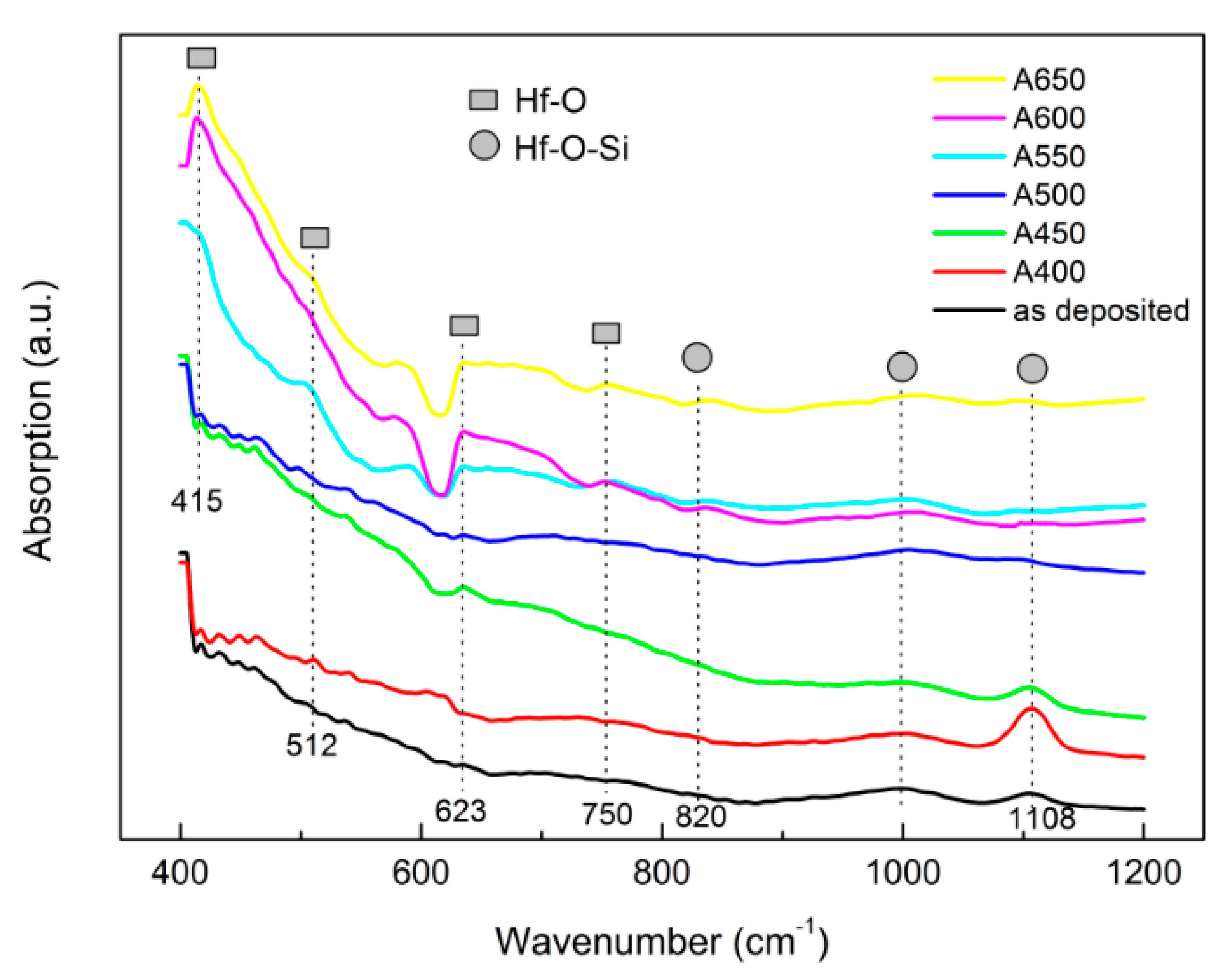
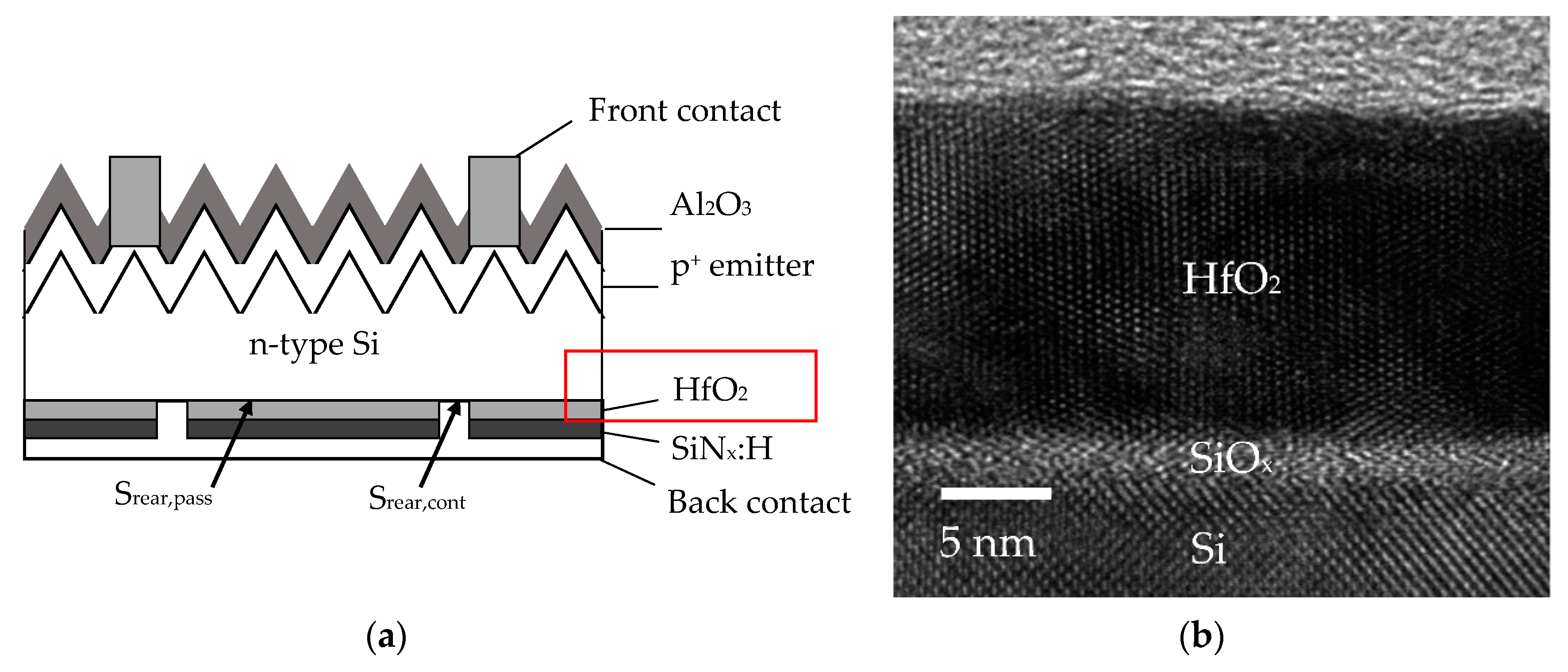
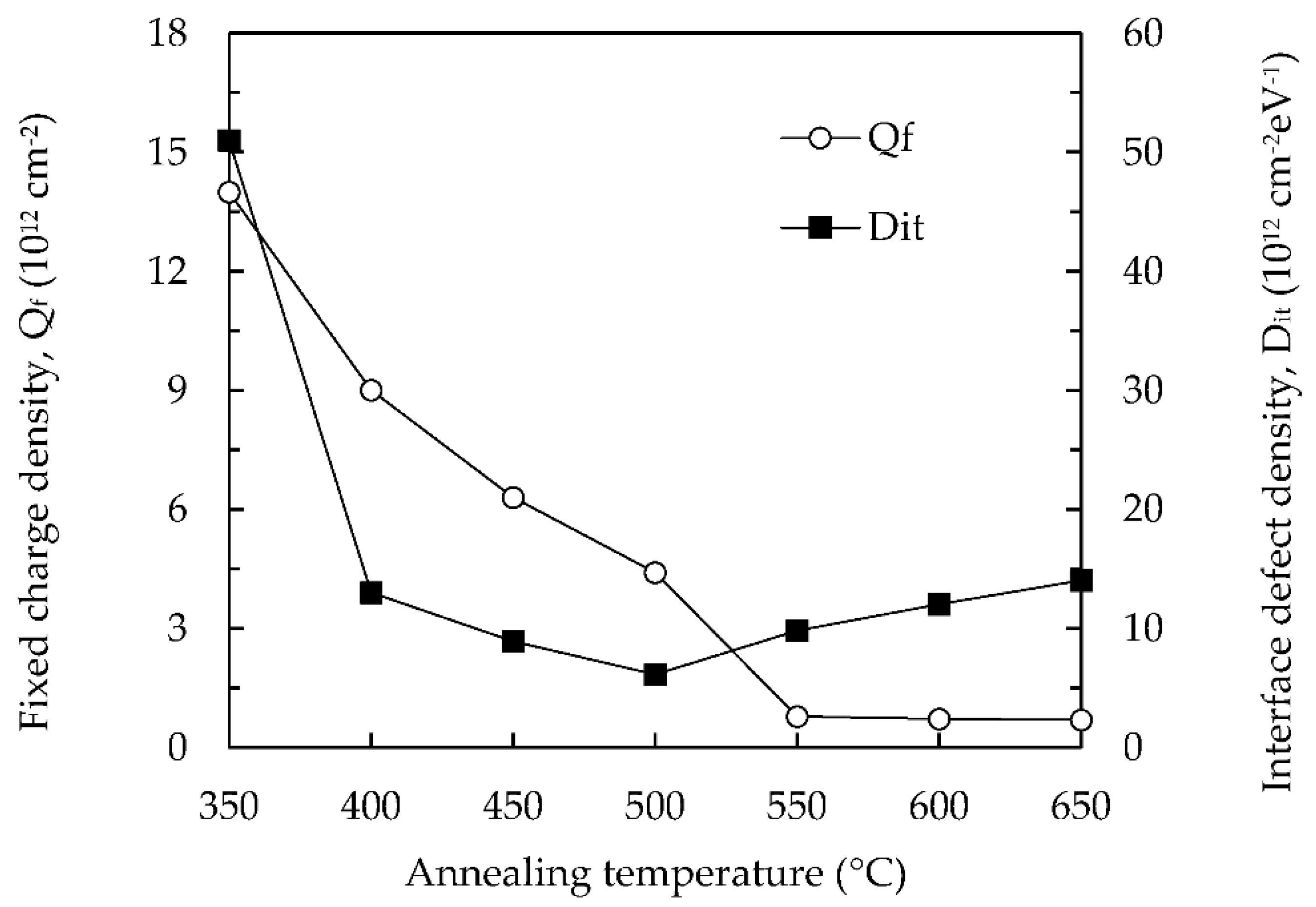
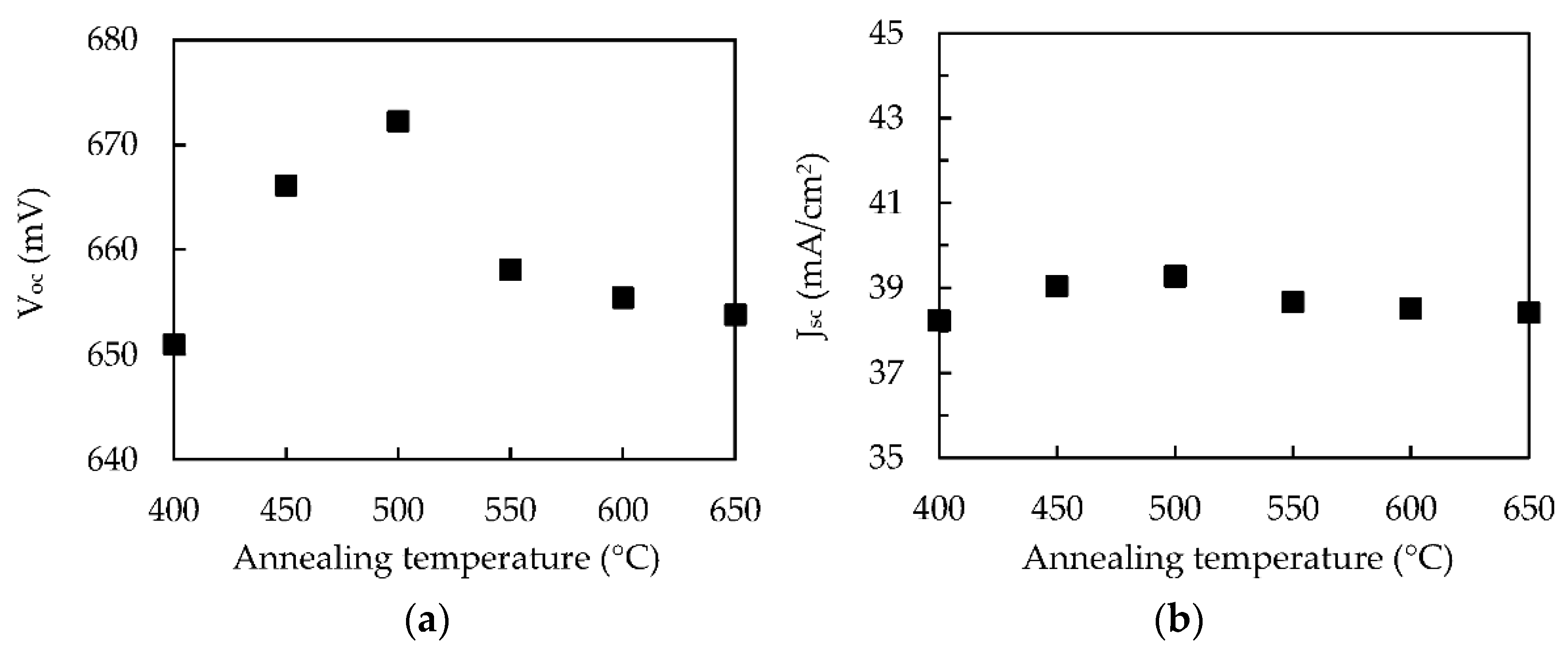

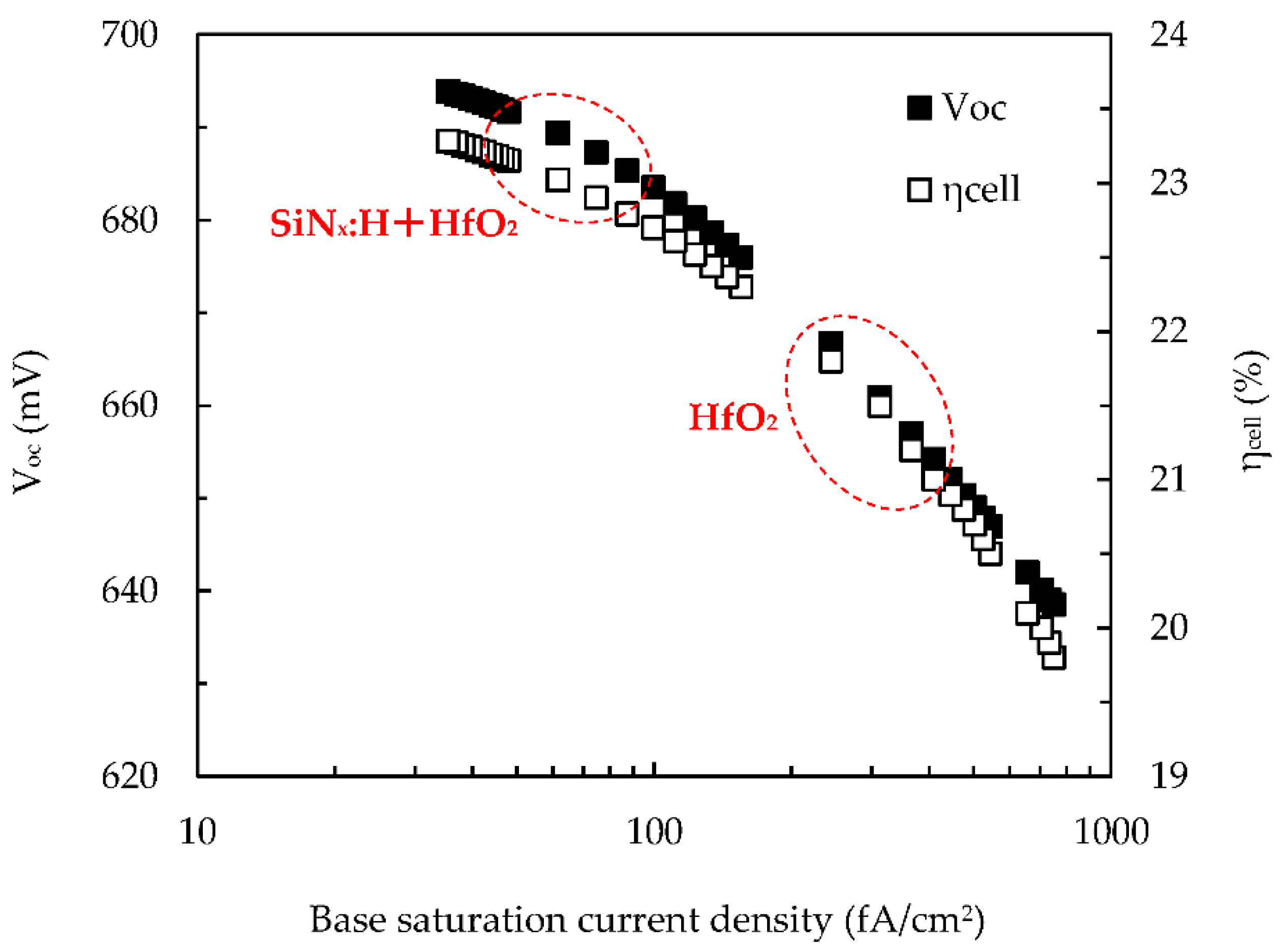
| Temperature (°C) | τeff,low (µs) | τeff,high (µs) | τeff,low/τeff,high |
|---|---|---|---|
| As-deposited | 0.5 | - | - |
| 400 | 14.3 | 15.2 | 0.94 |
| 450 | 44.8 | 48.2 | 0.93 |
| 500 | 67.2 | 74.7 | 0.9 |
| 550 | 18.5 | 27.3 | 0.68 |
| 600 | 14.3 | 22.1 | 0.65 |
| 650 | 11.8 | 19.4 | 0.61 |
| Parameter | Value |
|---|---|
| 1 Front surface texture depth | 3 µm |
| 1 Exterior front reflectance | 3% |
| 1 Exterior rear reflectance | 100% |
| 2 Internal rear reflectance | 90% |
| 2 Emitter contact | 2.48 × 10−3 ohm |
| 2 Base contact | 1 × 10−6 ohm |
| 1 Wafer thickness, W | 200 µm |
| 1 n-type background doping, ND | 1016 cm−3 |
| 1 P+ emitter doping | 1020 cm−3 |
| 1 P+ emitter diffusion depth | 0.4 µm |
| 1 Bulk lifetime, L | 1000 µs |
| 2 Emitter saturation current density, J0e | 50 fA/cm2 |
| 1 Effective rear surface recombination, Srear,eff | variable |
© 2017 by the authors. Licensee MDPI, Basel, Switzerland. This article is an open access article distributed under the terms and conditions of the Creative Commons Attribution (CC BY) license (http://creativecommons.org/licenses/by/4.0/).
Share and Cite
Zhang, X.-Y.; Hsu, C.-H.; Cho, Y.-S.; Lien, S.-Y.; Zhu, W.-Z.; Chen, S.-Y.; Huang, W.; Xie, L.-G.; Chen, L.-D.; Zou, X.-Y.; et al. Simulation and Fabrication of HfO2 Thin Films Passivating Si from a Numerical Computer and Remote Plasma ALD. Appl. Sci. 2017, 7, 1244. https://doi.org/10.3390/app7121244
Zhang X-Y, Hsu C-H, Cho Y-S, Lien S-Y, Zhu W-Z, Chen S-Y, Huang W, Xie L-G, Chen L-D, Zou X-Y, et al. Simulation and Fabrication of HfO2 Thin Films Passivating Si from a Numerical Computer and Remote Plasma ALD. Applied Sciences. 2017; 7(12):1244. https://doi.org/10.3390/app7121244
Chicago/Turabian StyleZhang, Xiao-Ying, Chia-Hsun Hsu, Yun-Shao Cho, Shui-Yang Lien, Wen-Zhang Zhu, Song-Yan Chen, Wei Huang, Lin-Gui Xie, Lian-Dong Chen, Xu-Yang Zou, and et al. 2017. "Simulation and Fabrication of HfO2 Thin Films Passivating Si from a Numerical Computer and Remote Plasma ALD" Applied Sciences 7, no. 12: 1244. https://doi.org/10.3390/app7121244





